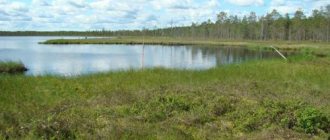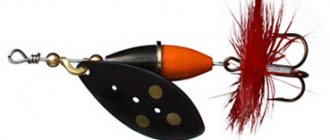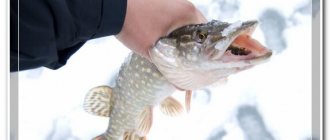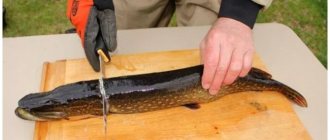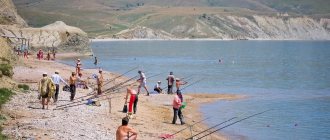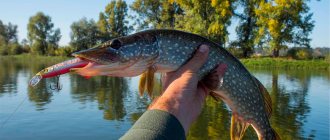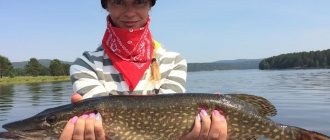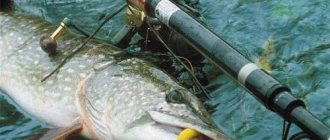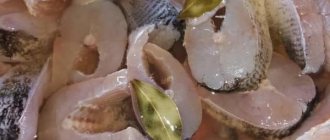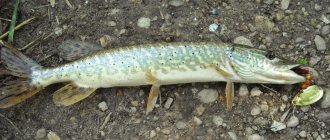Where to look for pike on a small river
Pike is a predator. It chooses a place to stalk and hunt, so it can often be found along the coastline in seaweed and fallen trees. The most common ambush sites are:
- coastal snags and thickets;
- at the intersection of rivers;
- next to the dams.
However, the range of pike is not limited to the listed places. It can be found in any other area. The migration of the huntress depends on pressure, weather, time of year and other factors.
It is worth noting that the shallower the river, the more careful the pike. If there are small fish in a pond, then there is probably a pike there too. In order for the catch to be successful, the angler must take into account the behavioral characteristics of this spotted fish and be patient.
Choosing a place for pike fishing in small bodies of water
To successfully catch pike in a small body of water, you need to find a promising place for the predator to stay. First of all, these are the confluences of any streams and small rivers into small bodies of water, channels with flow between small bodies of water, depressions at the turns of small bodies of water with flow. Or pits at the bottom of small lakes and ponds.
If in such places there are grassy islands on the surface, protruding parts of underwater snags, branches of flooded bushes, consider that you have found Eldorado. Let it be small, local scale, and with a medium-sized predator. But you will be provided with bites.
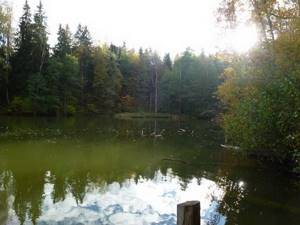
Koryazhnik is an excellent place for pike fishing in a small body of water
Selecting a spinning rod
When choosing fishing gear for shallow rivers, fishermen most often give preference to spinning rods. Fishing can be exciting, exciting and very successful. But in order for spinning fishing to be enjoyable, you need to choose the right equipment, taking into account the characteristics of the reservoir and the behavior of the pike.
The standard fishing kit, which is recommended by experienced spinning fishermen, includes:
- rod 2 - 2.5 meters long with a test weight of up to 20 grams, medium-fast or fast action;
- reel size 2000–3000, inertia-free, universal with a reduction of about 5.0:1, with good line laying and easy movement;
- braided cord and monofilament line with a breaking load of up to 4–6 kg, metal leashes.
It would be a good idea to have polarized glasses that will allow you to see what is happening underwater: the behavior of the bait and even individual pike exits.
About
What baits are best to use?
During the periods of autumn and spring “hunting” for pike, it will be optimal to use silicone non-snagging baits on an offset hook with a Cheburashka weight or mounted on a jig head. They are preferred because they penetrate into the most secluded places where pike can sit. The most common ones are:
- twisters;
- vibrotails.
In summer, pike are caught less readily, so first you should feed it, and choose the following as artificial bait:
- various types of wobblers (minnows, poppers, etc.);
- spinners (rotating spoons);
A basic set for fishing on a small river must necessarily include: minnow wobblers with neutral buoyancy from 8 to 12 cm, and a set of non-hooking jigs with weights up to 15 g.
Pike places on small rivers
The main problem is not that fishing for pike with a spinning rod on small rivers is complicated by the fact that the predator reacts worse to artificial baits, but the often insurmountable technical and tactical difficulties for this method of fishing. After all, for the most part, large pike stick to places that cannot be fished from a more or less distant distance. And when you get closer, when you can act for sure, there is a huge chance of spooking the fish, and it will no longer take the most beautiful bait; this is often even visible to the eye - it moves away to the side and was like that.
With live bait, the tactics themselves are radically different - they swam up, put the crucian carp into a suitable pike “hole” and swam away. Even if a predator was standing nearby and was alerted, it will not go far, will soon calm down and return to the baitfish, cutting circles. This is the only advantage over spinning, but it is significant in the fishing conditions offered to the fisherman by the “cunning” small river.
But if the pike does not see the fisherman, then it is not afraid of anything. There was a very significant case recently. When fishing with a circle, the pike seemed to be hooked reliably, but in the process of fishing it went away - the hook broke. I replaced the live bait with a fresh one, and after half an hour the bite started again. Is there a flock of pike standing here? No, I take it out, and a broken hook sticks out in her mouth - it’s mine, I won’t confuse it with someone else’s.
The most typical places where pike take are not so diverse
A fairly dense pitcher plant works reliably, where the predator is most common. One experienced fisherman once told us: “If you saw water lilies, put a circle, you won’t be mistaken, pike always lives in water lilies.” You’re unlikely to hook a large one, but a medium-sized one is no problem. True, there is one peculiarity - the water lilies are full of pike when the water is not very clear. If the bottom is visible at a depth of a meter, then the toothy one leaves the water lily, both in summer and in autumn, moving closer to the snag, to the dumps of the pits. But clear water in small rivers in summer is quite a rarity, I complain a little about this, since I also like to dive, seeing with my own eyes that even with underwater visibility of a meter there are very few pike in the water lilies, mostly outright trifles.
Snag holes are also always promising for fishing; at the end of summer, when the water gets colder, they become even more densely clogged with pike. Moreover, the relationship is direct - the denser the snag and higher above the bottom, the more toothy it is and the greater the chance of catching a solid trophy. Often on small rivers there is such dense snag that it is absolutely impossible to fish directly in it. Then fishing on cans with placing live bait next to a snag, on a clean bottom, as long as there is no strong current here, it is desirable that there is some kind of lull present, the return, and the toothy one comes out of its den, reacting to the live bait.
It is better to ignore smooth, shallow runs, especially with a strong current - you can only run into a normal pike here by accident during its local migrations, and the small “grass” under the coastal grass is uninteresting. Entrances to oxbow lakes are very promising. Quiet coastal barrels under trees bent over the water, where you can also be exposed if the depths reach at least half a meter, and the slow-moving fish borders on a fast current.
And more about places with an eye to the season
It has been noted that in the hot summer the bite is usually worse, but specific places work stably. At the end of summer, the pike's appetite intensifies, but places begin to wander - the toothy one cannot sit still. I notice this thing as a submariner - it’s at the end of August, when the best chances are to wait for clear water, one day somewhere on the point and there are plenty of fry and pike, and I’ll come in a week, and even if the ball rolls, not a small thing, not a predator can not see. Although nothing has changed in nature - the temperature is stable, the atmospheric pressure is even. So at the end of summer - beginning of autumn, it makes sense to rearrange the live baits and work wider with the spinning rod, which I don’t see the need for in the height of summer. Otherwise, late summer catches may be worse than early summer ones, although the feeding activity and aggression of pike is higher in late summer and autumn.
Fishing technique and tactics
Fishing in shallow rivers has its own specifics. There are some rules, following which a spinner can boast of an excellent catch. Important criteria are:
- choice of location;
- movement along the river;
- approach to the place.
During the spring activation of pike, it can be caught almost everywhere. Then, after spawning, she calms down and stands in one place for hours.
It is necessary to choose an approach in which there is a lot of coastal vegetation, preferably the presence of snags and fallen trees. It is at such points that pike arrange ambushes. Sometimes such approaches are inconvenient and seem difficult to achieve. But there are “fishing spots” there. If you are not lazy and make your way to a hard-to-reach shore, you can enjoy active fishing and a good bite.
In order not to scare the pike, you need to approach the fishing spot as silently as possible. The first test casts should be made close to the shore in order to thoroughly probe the coastal strip. Then you can move forward.
If the place is inaccessible from the shore and you need to walk through the water, then you should move with the flow. Sometimes fishermen notice that fish move away from the shore because a person made too much noise and scared them away. This type of pike is considered lost and will treat bait with great caution.
About
Pike of small reservoirs
This voracious, cunning, but cautious predator can be caught at any time of the year. But unsuccessful pike fishing in the summer leads to the fact that some fishermen completely forget about it in the fall. But in vain they do this. You can also hunt for pike in the fall, and it’s not bad at all. You just need to know where exactly to do it and avoid the mistakes that some people often make.
In late autumn, as usual, inclement weather sets in. Catching pike from the lady's boat becomes impossible. It is also impossible to catch it from the shores of large bodies of water; you simply cannot get it. The water becomes colder at this time. For this reason, floating green plants die off, larger representatives of aquatic flora will dry out and the water will become more transparent. In such reservoirs, in shallow water, in water saturated with oxygen, the predator loves to be at this time.
This is especially typical for reservoirs where a sufficient number of different species of fish live. It is in such shallow, small-sized bodies of water that this predator should be hunted in late autumn.
However, many believe that only bee-eaters are found in such small bodies of water, and there have never been any traces of large specimens here. This is an absolute statement that does not deserve any discussion.

Signs of the presence of large individuals
Based on a number of characteristic features, we can conclude that it is here that there is an opportunity to get a large trophy.
- 1. The reservoir is very rich in natural live food for pike. There are many perches and other fish species.
- 2. The average weight of caught specimens of squints approaches five hundred grams.
- 3. In winter, this body of water almost never freezes completely to the bottom.
- 4.Test marks from the teeth of caught squint or other fish, more than ten centimeters.
- 5. The presence of schools of perches of different numbers, very active in their behavior.
Small active perches always attract pike, because it is the perch that is the predator’s favorite treat. Pike are certainly not as active in feeding as perch. She has long intervals between meals. She needs to digest large prey, and this takes time. But when she gets hungry, she goes hunting. In response to this, the perches seem to become quiet and the bites stop. This is a signal to the fisherman that there is a pike somewhere nearby.
Also interesting: Catching pike with live bait in snags in winter
Practice shows that quite often decent specimens of Her Majesty’s pike are caught in small rather than large reservoirs. This is understandable, because logically the probability that bait on a small lake will be found in its immediate vicinity is much higher than, say, on a huge reservoir. The bait is in one place, and the pike is a kilometer away from it. Catching this predatory representative in small reservoirs has its own nuances.
At the same time, fishermen often make the same typical mistakes
- 1. The size of the bait is too small. Considering that there are no large specimens here, the fisherman also uses a small-sized spoon. The golden rule says that the ideal bait is one that is commensurate with the fish that the pike feeds on, and for a predator this is neither more nor less, but ten percent of the mass.
- 2. Having made unsuccessful attempts to catch pike in hot weather in the summer, many anglers generally put spinning on the back burner. All this, of course, is in vain. After all, it is on small bodies of water in the fall that she feels freedom, harmoniously combined with her predatory nature. Hunting for predators here is not only possible, but also necessary.
- 3.Frequent use of artificial bait. In small bodies of water, the predator is deprived of the opportunity to frequently swallow live bait. But she needs to grow. We must learn to use live fish more often when catching this predator.
- 4. Sometimes the fisherman simply does not have enough endurance and patience. The specificity of small-sized reservoirs suggests that for a short time, they, as they say, pass along and across it. There is no bite, no trophy and the fisherman simply leaves, concluding that fishing here is useless. But this is done in vain. You have to stay and continue fishing and luck will certainly smile.
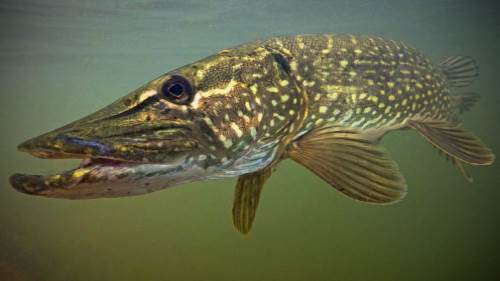
Practical experience of catching this predator shows that, despite the fact that there was not even a single bite during the day, it is highly likely that it will bite in the evening. We should not forget that pike do not feed every hour, or even every day. Also interesting: Fishing for pike in the grass
Having made a throw once and caught a large prey, it will digest it for a long time. But when she gets hungry again, the chances of catching her will increase enormously. Then the next time you come to a pond, even if it seems too shallow, small and unsuitable for pike to live in, you must make every effort to prove the opposite.
You can look for one or another body of water for the upcoming autumn fishing for large predators by simply asking the fishermen living here who prefer fishing with a regular float rod. It is worth asking them in detail which fish are mainly found in it. Has it become less over the last, say, year, or, on the contrary, has its quantity increased?
If the roach or sleeper has become larger, but their number has decreased, this means that the pond has been populated by pike and perch. In addition, you need to ask if the caught specimens have any characteristic marks. If the number of such fish has increased, i.e. Since they are actively breeding, it is useless to catch pike here, it is simply not here. Of course, rare individuals may appear with the introduction of waterfowl eggs, but the cramped conditions of a small reservoir do not allow them to reproduce properly.
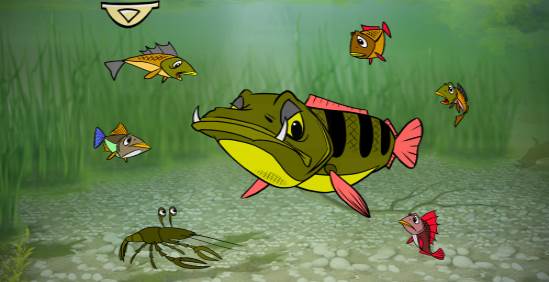
An amazing feature of this far from stupid predator is that it has an excellent art of camouflage. Provided the water is fairly transparent, it is not always possible to see it. But this does not mean that the pike cannot be visually detected at all.
During the spawning period, the predator, in the heat of the excitement of love games, often splashes out of the water. Thus, you can clearly see what kind of trophy you will eventually catch, which will be a specific reason for the fisherman’s pride.
Category: Pike fishing
Features of fishing in spring
Spring fishing has its own nuances. Usually, pike go out to spawn after the ice has melted and the water has warmed up to a temperature of +4 to +9°C. You can’t count on a good catch during spawning: the fish are sluggish and passive. But immediately after spawning, the golden time for fishermen begins - the spring zhor. During this period, the “spotted” one grabs any bait without thinking.
Pike bite consistently well in May. In low-water rivers, by this time the water is well warmed by the sun, and small fish, its main food, are active and playful.
Spring pike goes hunting and attacks various baits. Usually it stands in shallow water, waiting for prey that goes to spawn.
By summer, the pike becomes lazy and is active only at dawn. The feeding schedule is improving, and she is no longer ready to grab any thrown bait. Preferred weather is cloudy, rainy days.
Early spring in March, April
After a long and cold winter, the pike is hungry and when the first warm days arrive, it tries to replenish its energy reserves. Spring zhor is the most favorable for fishing. The first zhor begins when the ice is just melting and has not yet left the river. This is the pre-spawning activation of pike. Then, when the ice breaks up, the fish go to spawn. During it, you can forget about hunting - the predator stands still. Then comes the peak of activity, during which you can catch an average of 10 tails per fishing trip!
About
Fishing club "Samson"
A. Demidovich
How to catch pike in a suburban pond? The question is relevant for all spinning players, both experienced and beginners. But how to catch a large fish is something that significantly fewer pike anglers are interested in.
Small and large pike extremely rarely overlap their habitats. It has long been known that large, and not only large, individuals of pike are cannibals, and the main food supply for “pencils” and “mothers” is different. By small and large, for our situation, we mean fish weighing 600 g and at least 1.5-2.0 kg. Of course, in principle, there are not so many fish weighing 2 kilograms or more in suburban ponds and rivers, so there is nothing to blame here on one lack of skill. The main reason for the absence of large specimens in catches is lack of time, simple laziness or unwillingness to understand the situation and think.
Just honestly ask yourself on the way to fishing: “What will give me more pleasure - 4 pieces of 600 g each plus a couple of perches or one for 3.5 kg, but maybe not this time?” If you are confident in the first option, feel free to collect light tackle - you will have more perches, and you will get adrenaline from the pike. If you are not sure of the answer, you hesitate - it’s better to continue catching 4 x 600 and perch - it means you haven’t caught it yet, and you will be tormented by doubts throughout the fishing. And only if the answer does not raise any doubts - then relax... and catch “either nothing or one, but a large one,” and a couple of 600 g pike will most likely end up in the “bycatch” anyway!
Selecting tackle
Do you want a big pike? This means that you are putting in a serious bait, and the safety margin of the tackle should not cause any concern - that means no lights! Everything is serious. Tough, powerful, with leashes and other things. Check everything in advance at home on the steelyard. Among the auxiliary means - a hook (provided that you know how to use it) or a large landing net.
Boat
It's better if there is one. Even in a small body of water it is much more convenient to move on a boat: there is less noise, it is easier to free yourself from a snag, there are fewer competitors, and, most importantly, there are more “unshot” points and positions.
Fishing places
This is the most important thing, because in small reservoirs, as a rule, it is difficult to determine the presence of a channel, edge, hole, etc. by coastal landmarks. Often this most treasured hole is located just a couple of meters from a seemingly hopeless sandy beach. So finding places is the main task at the initial stage of development of a reservoir.
In the spring. Immediately after spawning, pike should be looked for in the shallowest places, next to the spawning grounds (in the grass, on irrigation, etc.), even better if there is a snag or depth next to the shallows, or both, plus a stream or spring - it's a fairy tale! These are, of course, truisms, but there can really be a lot of them here, including major ones. Such happiness as the post-spawning zhor does not last long; after this, large fish remain almost all the time at a relative depth until the end of the ban period. During this period, the pike is extremely lazy, and in order to catch it, it is best to simply methodically “bomb” known deep points (for example, the deepest places on the pond."
Small pike, as a rule, are dispersed throughout the shallow waters, naturally, regardless of their spawning sites. And with the complete warming of the water, the beginning of the flowering of all kinds of underwater vegetation, mosquitoes and other attributes of summer, large pike again begin to visit shallow water, because it is here that millions of small fish flock, looking for shelter, food and warm water.
In summer. Most of the time, larger pike generally prefer to be at depth, and also preferably near a spring or near a current, and, being in a half-asleep state, they go out to “meal” very rarely. This has also been known to everyone for a long time, and most of us prefer not to engage in targeted fishing for “large fish” at this time. Because it is very difficult to calculate the short activity interval and feeding place of the pike, and even more so to guess the whole “alignment” at a glance.
Small pike are active throughout the summer season. Well, perhaps in the hottest weeks he will give up daytime feeding and begin hunting at the earliest dawn, before the water warms up from the night. But, oddly enough, it is during the daytime that very respectable specimens of the “spotted one” unexpectedly become our trophies, and very often. In my opinion, this is due to the fact that decent fish cannot afford to chase the nimble morning fry and the perches pursuing them. To save energy, she goes hunting by noon, when both the small fish and the average food fish have already frolicked, have eaten and stand lazily, digesting food. At these very moments, it will not be difficult for the pike to watch for slow and tired fish. You can find them just under the shore, standing in the grass, in shallows, etc. Often the future trophy stands in an adjacent shelter for half a day, just half a meter from the frolicking roaches and does not attack. And only at its certain time it moves from its place, quickly eats and after 10-20 minutes it freezes again until the next day, lazily moving its gills.
Therefore, catching it even in a known parking place will bring no results. The tactic of systematically combing the adjacent shallow waters will be much more effective. Having gone out to feed, the predator becomes more active and moves much more and reacts to larger baits, so you will need to put something heavier than spinner No. 2.
Autumn. Undoubtedly, this is the most “trophy” time for pike fish. However, on small bodies of water, the period of autumn feeding is not at all as extended in time as on large ones, and you can count on a good catch within just a half-month, hardly longer... Bursts of its activity, as a rule, become more frequent up to several per day, compared to in the summer, and now it stays exclusively in the deepest places. Catching a pike is much more difficult than on a large body of water, only because the main advice is simple to the point of banality - look for these deepest places. It is not worth staying for a long time at each surveyed site. It’s not summer anymore, the fish are much more active, and if they are here, they will most likely show themselves after a series of targeted, deliberate casts. This is where bait comes to the fore.
Lures
I won’t recommend anything revolutionary new. Lures that have been tested for years and are optimally suited to our conditions are wobblers, spinners, spinnerbaits and light jigs. Arranged in descending order, according to the degree of catchability and personal preferences of the author.
In the spring. The most catchy ones are small and medium-sized wobblers with high-frequency vibration spectra. Why is that? It’s difficult to explain, but for me the best performance was based on their strained humming wiring. Or maybe she is simply more active and therefore not averse to chasing quick prey. Or the rest of the fish are still quite passive, and such vibrations simply stand out very well against the general acoustic background of the reservoir and thereby attract it.
In summer. Time for a spinnerbait (in my opinion, nothing better has been invented for grassy shallow waters) and all sorts of “twitching”. The best results will be obtained by something mine-shaped and conducted as unevenly as possible. There is plenty of food around, and the pike will most likely be attracted only by something that does not resemble anything else in its animation, or that resembles a wounded fry. Why, no one except the pike itself will say. But it was with baits of this class that the most significant catches occurred. It’s also a good idea to surprise the pike with a variety of fancy colors of the baits used. In general, the more unusual everything is, the better.
In autumn. The undisputed leaders here are large low-frequency “lazy” wobblers. It’s even better if the depth of their immersion is slightly the maximum depth of the reservoir. Along with the size of the bait itself, in my opinion, the vertical component of their movements, both diving and surfacing, is very much in demand at this time of year. It is only desirable that it is not a cork-like jumping out, but something like a slow waddle from side to side during a smooth rise from the depths. Large spinnerbaits and spinnerbaits are also very catchy, but straight-line wiring, although it speeds up the “punching” of the area, leaves a lot of “white spots” in the explored area. Along with the immersion/ascent of a wobbler, step-by-step wiring of a light jig works great. The only difficulty here is that you can’t pull out a pike from afar with a small and “quiet” bait and the penetration of the point must be very tight, literally every meter of the hole has to be filtered - after all, you need to get almost under the fish’s nose.
The most important
Try to mentally shrink a large reservoir to the size of a small country pond. All interesting places, snags, beaches, holes, etc. will be very close to each other, and in this way our task seems to be simplified. Just reduce everything else too! In our case, we will have to stand on the point with an accuracy of 1 m, no “it seems to be somewhere here”! The direction of casting is also important - you can throw half a meter to the right / left of the desired groove all day long, but to no avail.
The situation is the same with seasonal changes. In deep water, which cools down and moves, it gradually adapts to different behavior patterns. Here, a two-meter thick pond easily cools down by ten degrees in a week. Accordingly, the pike accelerates! Speed up too! On a large body of water there is a much higher probability of catching random “bad” fish. We practically don’t have it! Of course, not because she is smarter, she is just smaller and much more difficult to “calculate”. Therefore, use your head, do not confuse persistence with obstinacy, and clear, meaningful, persistent actions will definitely lead to success sooner or later!
encyclopedia “Going fishing”, 2006
